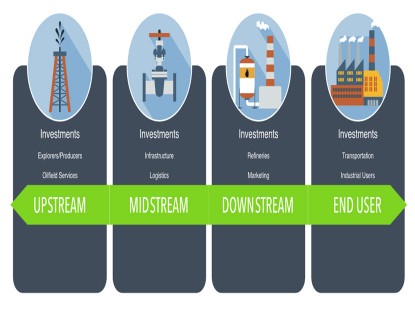What’s Driving Midstream Company Performance?
The Portfolio Managers Ben Cook, CFA and Josh Wein share their insights on midstream companies’ strong performance over the past year, their shareholder-friendly capital allocation approach and current valuations.
-
 Ben Cook, CFAPortfolio Manager
Ben Cook, CFAPortfolio Manager -
 L. Joshua Wein, CAIAPortfolio Manager
L. Joshua Wein, CAIAPortfolio Manager
Key Takeaways
» Midstream companies outperformed the overall equity market in 2024.
» We believe the new presidential administration sees the U.S. energy industry as a source of strength, and as such, will likely work to unlock energy resource.
» Several macroeconomic trends could positively impact midstream companies, including increased energy demand, stable energy prices and rising M&A activity. We believe these tailwinds will allow the U.S. to grow in its role as a hydrocarbon supplier to the global market.
» Rising midstream sector dividend and distribution payout has been accompanied by improving distribution coverage and declining leverage.
» Despite recent strong performance, midstream valuation remains attractive relative to historic valuation norms.
What drove the significant outperformance of the midstream sector versus the overall equity market in 2024?
In 2024, the Alerian US Midstream Energy Index rose 50%, double the S&P 500® Index return of 25%. We believe multiple factors were responsible for this outperformance. Steady upstream sector production volume growth, favorable commodity pricing, and the continued midstream company focus on shareholder return enhanced midstream sector investment merit during the period.
Substantial electricity demand required to fuel artificial intelligence (AI) computing power along with increased liquefied natural gas (LNG) exports propelled growth in U.S. natural gas demand during the period. In turn, increased natural gas demand benefited midstream operators that gather, store and transport natural gas.
Midstream company capital allocation practice was also a bright spot during the prior year. Aligned with investors, midstream sector management teams continue to focus on debt reduction and shareholder payout growth in the form of rising dividends as well as share and unit repurchases. We believe these actions attracted greater investment interest in the sector.
Midstream companies have attracted yield-oriented investors because of their dividend payouts. How reliable are these dividends?
Midstream companies pay a healthy level of dividends. As of the end of 2024, the average yield of midstream C-Corps and midstream master limited partnerships (MLPs) was 6.1% and 7.5%, respectively1. We believe sector dividend/distribution levels remain reliable given that midstream sector free cash flow, distribution coverage, and leverage metrics have materially improved in recent years. Prior to 2019, the average distribution coverage ratio in the midstream sector was less than 1.6x, so every $1 in payout per share/unit was covered by $1.60 distributable cash per share/unit. In 2023, the coverage was 1.88x. Going forward, the coverage ratio is expected to remain high. Over the next 5 years, the average distribution coverage is forecasted to be 1.8 to 1.9x1. Midstream companies have also reduced their leverage. Investment grade Midstream sector leverage (debt to EBITDA) was 3.7x at year-end 2024; prior to mid-2021 leverage was above 4x1.
Would you please discuss valuations?
We believe midstream companies look attractively priced:
• Master limited partnerships (MLPs) continue to trade at a discount to their long-term average. As of the end of 2024, the EV to estimated 2025 EBITDA of the MLP sub-group was 8.8x relative to the 10-year average of 10.4x on the same basis.
• For midstream C-Corps, the group is currently trading around 11x, slightly below their 10-year average of 11.7x.
Combined with higher-quality balance sheets, consistent distribution growth, and higher distribution coverage ratios, we believe midstream companies offer a compelling entry point.
How could the new presidential administration’s energy policies benefit midstream companies?
We believe the new administration sees the U.S. energy abundance as a source of strength, and as such, will likely work to unlock that resource. Specifically, the administration could provide a potential tailwind by loosening restrictive regulations, including improving access to federal lands and easing permitting impediments. Most notably on a near-term basis, we will likely see a lifting of the pause on LNG export facility approvals. In this environment, we believe the hydrocarbon sector will continue to grow, ultimately benefitting midstream companies in general.
What macro factors could drive outsized performance of midstream companies?
There are several macroeconomic trends that could positively impact midstream companies:
1. Increased natural gas demand from AI use and the electrification trend. We expect the expanded use of natural gas will ultimately provide a tailwind to many Midstream companies in 2025.
2. Merger and acquisition (M&A) activity. Upstream producers continue to seek productivity gains and cost efficiencies. We believe management teams will remain focused on the pursuit of scaled operations, which should support longer term supply growth.
3. The U.S.’s important role as a supplier of crude and liquids to the global market. Liquids are a primary feedstock for the petrochemical industry and used in manufacturing plastics and goods that are increasingly in demand by consumers and other growing parts of the world such as Asia and India.
4. Stable energy prices. Despite two major conflicts around the world—the war in Ukraine and tensions in Syria—there have been minimal energy disruptions, and the price of oil has remained stable. For example, NYMEX West Texas Intermediate crude oil traded between $65 and $86 per barrel during 2024.
- In this article:
- Energy
- Midstream Fund
You might also like
-
 Investment Idea
Investment IdeaDefining the Energy "Value Chain"
 Ben Cook, CFAPortfolio ManagerRead the Investment Idea
Ben Cook, CFAPortfolio ManagerRead the Investment IdeaEnergy is a large and complex sector. The sector’s broad sub-industries can be divided into a “value chain,” each segment of which has different characteristics and offers different investment opportunities.
-
 Portfolio Perspective
Portfolio Perspective
Energy Transition FundEnergy Transition Outlook 2025 – Key Investment Opportunities
 Ben Cook, CFAPortfolio Manager
Ben Cook, CFAPortfolio Manager L. Joshua Wein, CAIAPortfolio ManagerRead the Commentary
L. Joshua Wein, CAIAPortfolio ManagerRead the CommentaryThe U.S. continues to be an engine of growth when it comes to energy production. The following commentary summarizes the 2024 market and what to expect in the new year.
-
 Portfolio Perspective
Portfolio Perspective
Gas Utility FundDrivers of Natural Gas Utilities in 2025
 Ryan C. Kelley, CFAChief Investment Officer and Portfolio Manager
Ryan C. Kelley, CFAChief Investment Officer and Portfolio Manager L. Joshua Wein, CAIAPortfolio ManagerRead the Commentary
L. Joshua Wein, CAIAPortfolio ManagerRead the CommentaryFollowing natural gas utilities’ strong 2024 performance highlighted by robust earnings growth, many factors could drive the stocks in the new year including U.S. energy policies, artificial intelligence (AI), and attractive dividend levels.
